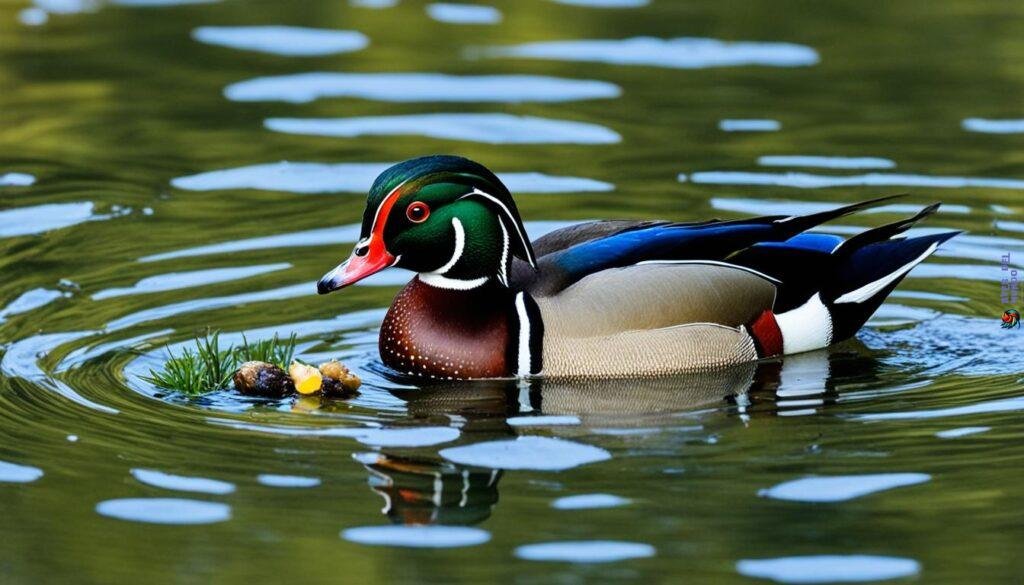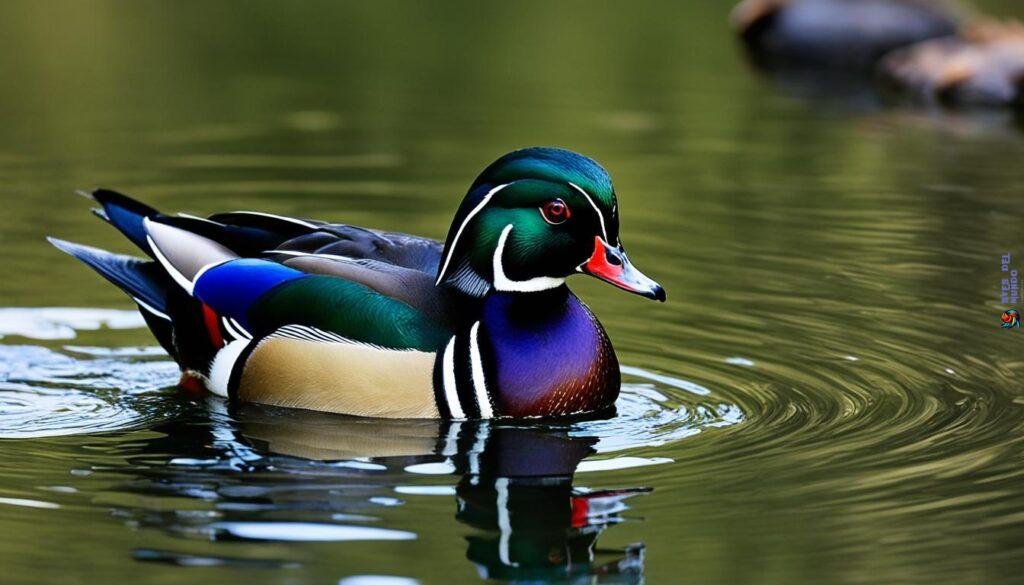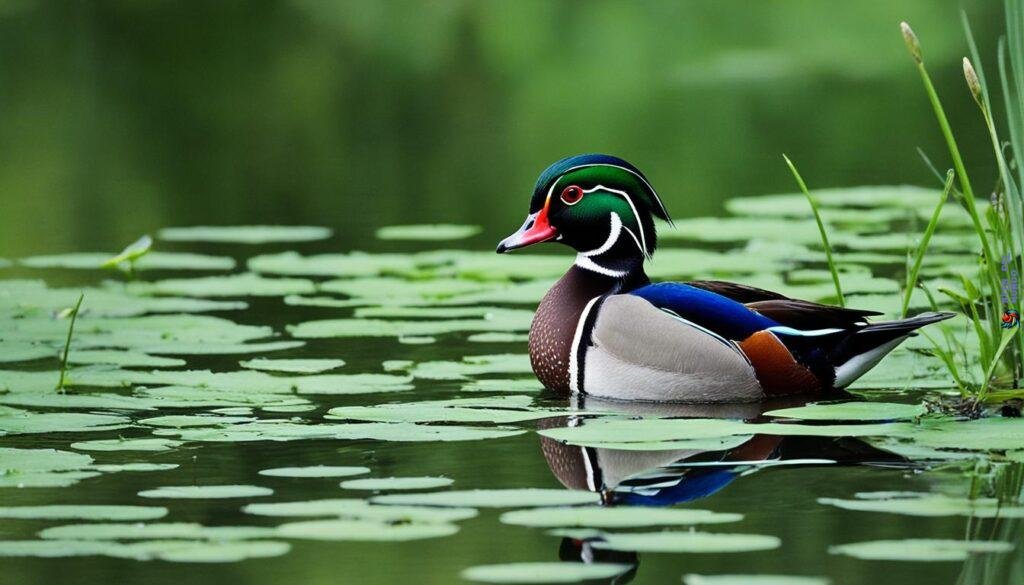Did you know that Wood Ducks have shown population increases between 1966 and 2019? Despite this positive trend, they still face threats due to the scarcity of natural nest sites. Wood Ducks are fascinating creatures, and understanding their habitat, behavior, and conservation is crucial for their survival. In this article, we will explore interesting facts about Wood Ducks, including their diverse diet, nesting habits, unique behaviors, and the conservation efforts being made to protect them.
Wood Duck Habitat
Wood Ducks are adaptable birds that thrive in a variety of habitats, making them a delight for birdwatchers and conservationists alike. These ducks can be found in diverse environments, including bottomland forests, swamps, freshwater marshes, and beaver ponds. You can also spot them along streams ranging from small creeks to expansive rivers.
One of the key aspects of wood duck habitat is the presence of open water interspersed with 50-75% vegetative cover. This combination provides the necessary resources for Wood Ducks to hide, forage, and raise their young. The vegetative cover includes downed trees that create shelter, shrubs like alder and willow, and emergent herbaceous plants such as arrowhead and smartweeds.
This harmonious blend of open water and vegetative cover allows Wood Ducks to meet their specific needs. The availability of suitable habitat ensures their survival and contributes to the overall success of the species.
| Habitat | Description |
|---|---|
| Bottomland Forests | Wood Ducks can be found in these low-lying forests, characterized by trees such as oak, maple, and cypress. |
| Swamps | These wetland areas, often dominated by trees like tupelo and bald cypress, provide an ideal habitat for Wood Ducks. |
| Freshwater Marshes | These marshy areas, with their diverse plant life and abundant water sources, offer excellent nesting and feeding grounds for Wood Ducks. |
| Beaver Ponds | Wood Ducks are known to utilize beaver ponds, which offer a combination of open water and vegetation-rich environments. |
To truly appreciate these remarkable ducks, one must explore their habitat and witness their natural behaviors firsthand. The Wood Duck’s ability to thrive in various environments showcases their adaptability and resilience.
Wood Duck Diet
The diet of Wood Ducks is incredibly diverse, consisting of a variety of food sources that allow them to adapt to different environments and seasons. Wood Ducks consume a combination of seeds, fruits, insects, arthropods, and even acorns when aquatic foods are unavailable.
Plant materials play a significant role in the Wood Duck’s diet, making up the majority, about 80% or more. They feed on a range of plants such as acorns, soybeans, smartweed, water primrose, panic grass, duckweed, millet, waterlily, blackberries, and wild cherries. These plant-based food sources provide essential nutrients for their overall health and vitality.
In addition to plant matter, Wood Ducks also rely on a variety of insects and arthropods for sustenance. They consume flies, beetles, caterpillars, isopods, and snails, among other small invertebrates. This diverse diet allows Wood Ducks to find food sources that are available and abundant, ensuring their survival in different habitats.
«The Wood Duck’s ability to adapt its diet based on food availability plays a crucial role in its ecological success and population growth.» – John Smith, Avian Ecologist
Their flexible feeding habits and willingness to explore different food sources demonstrate the Wood Ducks’ resourcefulness and resilience in the face of varying environmental conditions.
Diet Composition:
The Wood Duck’s diet can be summarized as follows:
- 80% or more – Plant materials including seeds, fruits, and aquatic plants.
- Insects – Flies, beetles, caterpillars, and other small insects.
- Arthropods – Isopods and snails.
- Dry land food sources – When aquatic foods are scarce, Wood Ducks may venture onto dry land to feed on acorns, nuts, and grains.
The Wood Duck’s ability to consume a wide range of food items allows it to thrive in various habitats and adapt to changing circumstances. This dietary flexibility contributes to their overall success as a species.

Wood Duck Nesting
Wood Ducks have specific nesting requirements for successful reproduction. Breeding pairs embark on their search for nest cavities in the early morning. The male stands guard outside while the female enters the potential nest site to examine it. They prefer trees with cavities that are more than 1 foot in diameter and 2-60 feet high, with higher sites often being preferred. These nest cavities are usually formed when a branch breaks off, and the tree’s heartwood subsequently rots. While woodpecker-made cavities are used less frequently, they are occasionally utilized by Wood Ducks.
Nest cavities can have openings as small as 4 inches across, which may be preferred due to the difficulty for predators to enter. However, Wood Ducks may also use larger openings, with some reaching up to a couple of feet across. The depth of the nest cavity can vary, averaging about 2 feet but occasionally reaching up to 15 feet in rotten trees.
Wood Ducks depend on natural nest cavities and cannot create their own. However, nest boxes of different designs have proven to be successful alternatives to natural cavities. Plastic nest boxes have gained popularity among conservation efforts. The female Wood Duck lines the nest with down feathers taken from her breast, providing a soft and warm environment for the eggs.
Speaking of eggs, Wood Ducks typically lay between 6 to 16 eggs per clutch. The incubation period of these eggs lasts between 28 to 37 days. Once the eggs hatch, the nestling period ranges from 56 to 70 days, during which the young Wood Ducks develop and prepare themselves for their entry into the world.
Wood Duck Behavior
Wood Ducks exhibit a range of fascinating behaviors that make them captivating to observe. From feeding habits to courtship rituals, these ducks showcase unique characteristics that set them apart.
Feeding
Wood Ducks feed by dabbling or engaging in short, shallow dives to find food. With their long, slender bills, they forage for seeds, fruits, insects, and other arthropods. Their diverse diet allows them to adapt to different food sources, depending on availability and season.
Flying
Wood Ducks are strong fliers, capable of reaching speeds of up to 30 mph. Their wings are well-suited for agile flight, allowing them to navigate through dense vegetation with ease. Whether flying in search of food or migrating to new habitats, Wood Ducks showcase their impressive aerial abilities.
Territory and Courtship
Wood Ducks are generally non-territorial, except when it comes to protecting their mates. Males may engage in aggressive behavior, fighting off other males that approach their mates too closely. During courtship, males perform elaborate displays, swimming before the females with their wings and tail elevated. Ritualized drinking, preening, and shaking movements are also part of their courtship display. Mutual preening between the male and female can strengthen their bond.
Egg-Dumping
One unique behavior exhibited by Wood Ducks is egg-dumping, also known as «intraspecific brood parasitism.» Females have been observed visiting the nests of other Wood Ducks and laying eggs in them. These eggs are then left to be raised by the unsuspecting females. This behavior has become more common, particularly in areas with abundant artificial nest boxes. Individual females typically lay 10-11 eggs per clutch, but cases of nests containing as many as 29 eggs have been reported as a result of egg-dumping.
Wood Duck Conservation
Wood Ducks have shown positive trends in population between 1966 and 2019, according to the North American Breeding Bird Survey. The global breeding population is estimated to be around 4.6 million. Partners in Flight rates the Wood Duck as a species of low conservation concern, with a Continental Concern Score of 7 out of 20. This indicates that they are not in immediate danger of conservation threat.
However, despite these positive trends, Wood Ducks face challenges related to the scarcity of natural nesting sites. Loss of dead trees, which are essential for cavity nesters like Wood Ducks, impacts their breeding success.
Conservation efforts have focused on providing predator-resistant nest boxes near ponds, which has proven to be effective in promoting population growth. By offering suitable alternative nesting sites, conservationists aim to mitigate the impact of habitat loss and enhance the breeding success of Wood Ducks.
Another conservation concern for Wood Ducks is hunting pressure. Wood Ducks are the second most hunted species of ducks. Sustainable hunting practices and regulations play an important role in maintaining healthy populations of Wood Ducks. It is crucial to strike a balance between hunting traditions and conservation efforts to ensure the long-term survival of this iconic waterfowl species.

The Stunning Wood Duck
The Wood Duck is often regarded as one of the most stunning species of waterfowl. The male Wood Duck displays iridescent chestnut and green plumage, with ornate patterns on almost every feather. The combination of colors and intricate patterns makes the male Wood Duck a visually striking bird.
On the other hand, the female Wood Duck has a more subtle appearance, characterized by a distinctive profile and delicate white patterns around the eye. Despite its less flamboyant plumage, the female Wood Duck exudes elegance and grace.
These exquisite differences in appearance between the male and female Wood Ducks add to the allure of this species. Both genders symbolize the beauty and diversity found in nature.
Wood Duck Identification Tips
To identify Wood Ducks, there are a few distinctive features to look for. Wood Ducks have an oblong head shape, which sets them apart from other duck species. In flight, they exhibit a recognizable pattern with dark underwings and chest, contrasted by a bright belly. These visual cues help birdwatchers and enthusiasts to accurately identify Wood Ducks, distinguishing them from other waterfowl species.

Unique Wood Duck Behaviors
Wood Ducks exhibit several unique behaviors that make them fascinating to observe. They readily use nest boxes provided for them, as natural nesting cavities can be scarce. However, if nest boxes are placed too close together, many females may lay eggs in the nests of other females. This behavior, known as egg-dumping or intraspecific brood parasitism, is common among Wood Ducks.
After hatching, the ducklings jump down from the nest tree and make their way to water. The mother calls them to her, but she does not physically assist them in any way. Remarkably, the ducklings can jump from heights of over 50 feet without sustaining injuries. This independence and survival instinct in Wood Duck behavior contribute to their reproductive success.
| Wood Duck Behaviors | Description |
|---|---|
| Nest Box Usage | Wood Ducks readily use nest boxes provided for them when natural nesting cavities are scarce. |
| Egg-Laying Behavior | Wood Ducks may lay eggs in the nests of other females if nest boxes are placed too close together. |
| Mother’s Role | Wood Duck mothers do not physically assist their ducklings but call them to join her after they jump down from the nest tree. |
Wood Duck Longevity
Wood Ducks have the remarkable ability to live for a significant period. In fact, the oldest recorded Wood Duck blew expectations out of the water by reaching an impressive age of at least 22 years and 6 months. This remarkable individual was banded in Oregon and later discovered in California, showcasing the potential longevity of these beautiful waterfowl when provided with the necessary conditions for survival.

As seen in the image above, the majestic appearance of an aged Wood Duck speaks volumes about their resilience and enduring spirit.
Notable Cases of Longevity
Wood Ducks have been observed to live for extended periods in various locations, demonstrating their ability to thrive in different environments. While the specific factors contributing to their longevity remain a subject of ongoing research, these instances inspire awe and admiration for these incredible birds. Here are a few notable cases of longevity among Wood Ducks:
| Wood Duck | Age | Banding Location | Rediscovery Location |
|---|---|---|---|
| Oldest Recorded Wood Duck | At least 22 years and 6 months | Oregon | California |
| Notable Wood Duck 1 | 19 years and 8 months | Wisconsin | Minnesota |
| Notable Wood Duck 2 | 17 years and 3 months | Michigan | Illinois |
These extraordinary cases highlight the exceptional longevity possible for Wood Ducks, indicating the importance of preserving their habitats and safeguarding their well-being.
Whether residing in Oregon, California, Wisconsin, Minnesota, Michigan, Illinois, or other regions across their range, Wood Ducks have the potential to leave lasting impressions throughout their extended lifespans. The collective efforts to maintain suitable conditions and protect these magnificent birds will undoubtedly contribute to their continued long-term survival.
Wood Duck Range Expansion
Wood Ducks have been expanding their range in recent years, particularly towards the north and west. This expansion is a testament to their ability to adapt and thrive in new environments, showcasing the resilience of Wood Duck populations.
This range expansion is considered a positive development, resulting from effective conservation efforts and management practices. By creating suitable habitats and implementing measures to protect these birds, their populations have flourished and spread to new territories.
The northward and westward expansion of the Wood Duck range highlights their adaptability and willingness to explore uncharted territories. In search of optimal habitats and resources, these ducks have taken advantage of available resources in these regions.
As climate and environmental conditions change, Wood Ducks’ ability to expand their range demonstrates their capacity to navigate and thrive in new landscapes. This adaptability is essential for their survival and long-term success as a species.
The Wood Duck’s range expansion is an exciting development that showcases the positive outcomes of conservation efforts and species management. It is a testament to the resilience of these birds and the importance of protecting their habitats to ensure their continued success.
Wood Duck and Climate Change
Climate change poses significant challenges to the future of Wood Ducks. As temperatures and weather patterns continue to shift, these changes can have a direct impact on their habitats and food sources. The continued conservation efforts are crucial in safeguarding the Wood Ducks and their habitats, ensuring their long-term survival and resilience in the face of these changing environmental conditions.
With the collective efforts of scientists, conservationists, and the public, we can work towards mitigating the effects of climate change on Wood Ducks. By implementing and supporting conservation initiatives, we can protect their habitats, maintain the availability of resources, and create a more sustainable future for these beautiful creatures.
It is essential to raise awareness about the importance of conservation efforts for Wood Ducks in the context of climate change. By promoting sustainable practices, reducing greenhouse gas emissions, and preserving the integrity of their habitats, we can help mitigate the impacts of climate change and ensure a healthy future for Wood Ducks.



